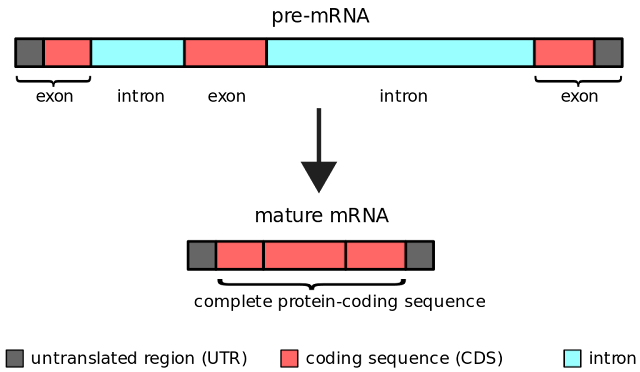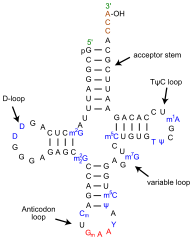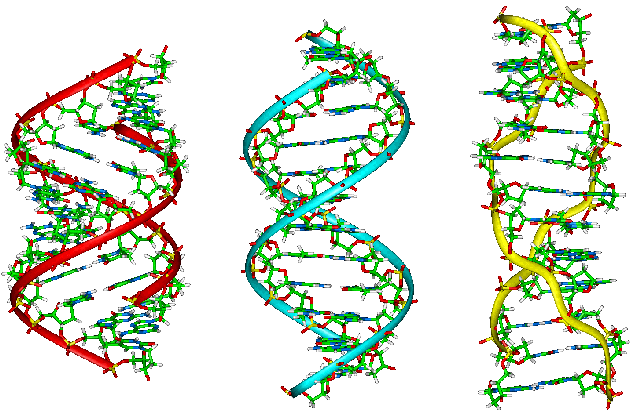What is DNA and RNA
Deoxyribonucleic Acid or DNA, is a double stranded molecule which contains sets of genetic information needed by an organism to live. These information are found in every cell of the body and is necessary for passing of heredity characters from parents to offspring.On the other hand,RNA is a single stranded molecule which is helpful in synthesis of proteins. These are often found in viruses and are genetic material of these retroviruses.
Popular FAQ's Answered In The Post
|
 |
| Comparison of structure of DNA and RNA |
Base pairs of DNA and RNA
There are 4 base pairs on each DNA and RNA respectively.DNA mainly consists of purine Adenine (A), guanine (G) and pyrimidine thymine (T), cytosine (C).
RNA also consists the above base pairs, but the pyrimidine base pair thymine is replaced by the base pair uracil (U).
We can see that there is a bond formation between A and T with formation of hydrogen double bonds and G and C with formation of triple hydrogen bonds.
The base pairing always follows the most important rule of pairing known as CHARGAFF’S RULE.
CHARGAFF’S RULE basically states that the number of purines is equal to the number of pyrimidines.
Key differences between DNA and RNA
S.No.
|
RNA
|
DNA
|
1.
|
Single stranded mainly.
|
Double stranded.
|
2.
|
Main sugar is Ribose.
|
Deoxy ribose is main sugar.
|
3.
|
Thymine is replaced by Uracil.
|
Uracil is absent and Thymine is present
|
4.
|
Does not follow Chargaff’s
rule.
|
Follows Chargaff’s rule.
|
5.
|
Can be destroyed by cyclic diesters of mononucleotides.
|
Due to absence of OH groups it can resist alkali action.
|
6.
|
Undergoes easy and fast degradation.
|
DNA is stable. The degradation is very slow.
|
7.
|
Mainly present in cytoplasm, but also found in nucleus.
|
Mainly found inside nucleus and extra nuclear DNA is found in
mitochondria, plasmids.
|
8.
|
The size is variable upto 100-5000 bases.
|
Millions of base pairs are present.
|
9.
|
Various types of RNA like mRNA, tRNA, rRNA, Sn RNA etc are present.
|
Only one Type of DNA is present.
|
10.
|
The different types of RNA do not change forms.
|
There are variable forms of DNA like A, B, Z.
|
11.
|
RNA is synthesized by DNA and cannot form back DNA (Exceptional in
case of reverse transcriptase).
|
DNA can form RNA by Transcription and also new DNA by Replication.
|
12.
|
There are many copies of RNA present per cell.
|
Only single copy of DNA present per cell.
|
Types And Functions of DNA and RNA
As we know from the central dogma of molecular biology that DNA maintains the code for the production of proteins and RNA is responsible to convert these codes into proteins.Major types of RNA
There are 3 main types of RNA which are as follows1. mRNA ( messenger RNA)
2. tRNA ( transfer RNA)
3. rRNA ( ribosomal RNA)
mRNA:
• Comprises only 5% of RNA in the cell.• It is heterogeneous in size and base sequence.
• As name indicates their function is to carry message signals from genes to protein synthesizing machineries.
 |
| Mature mRNA |
Characteristics of m-RNA:
- The 5’ end is capped with 7 methyl guanosine triphosphate cap
- This cap is responsible for the recognition of the mRNA by the translating machinery.
- It also protects mRNA from 5’ exonuclease.
- Most of the mRNA’s have a polymer of adenylate residues.
- This poly A tail prevents the attack of 3’ exonuclease.
- Many histones and interferons do not contain poly A tail.
- At 5’ end and 3’ end there are non coding sequence (NCS) which are not translated.
- The mRNA molecules are formed from DNA by the process of transcription.
- These sequences of mRNA are read in the form of codons.
- Codons are made up of 3 nucleotides.
T-rna:
• Transfer RNA are the smallest among the three RNA’s.• They transfer the amino acid from cytoplasm to protein synthesis machinery, hence they get the name transfer RNA.
• They are easily soluble and also called as “soluble RNA".
• They act as adapters for the translation of mRNA nucleotide into specific amino acids.
Structure of tRNA:
The secondary structure of tRNA shows excessive internal base pairing and acquires a clover leaf shape. Hence it is called as clover leaf model. |
| Clover leaf structure of tRNA |
The main arms of clover leaf model are:
1. Acceptor arm
2. Anti codon arm
3. DHU arm
4. T ¥ C arm
5. Extra arm
1) Acceptor arm:-
i. The acceptor arm is present at 3’end.ii. It has nearly 7 base pairs.
iii. The 3’ OH group terminal of Adenine boobs with carboxyl group of amino acids.
iv. The tRNA bound with these amino acids is known as amino acyl tRNA.
2) Anti codon arm:-
i. It lies at opposite end of acceptor arm.ii. About 5 bases pairs long.
iii. It is responsible of recognising triplet codon present in tRNA.
iv. Base sequence present in Anti Condon is complementary to the base sequence of mRNA.
3) DHU arm:-
i. It has about 3-4 base pairs.ii. It acts as a recognition site for the enzyme(amino acyl tRNA synthase) that adds amino acid to the acceptor arm.
4) T¥C arm:-
i. It is present opposite to DHU arm.ii. It gets it’s name due to the presence of pseudo uridine group.
iii. It involves in binding of tRNA to the ribosomes.
5) Extra arm or variable arm:-
i. These variable arms are present in about 75% of tRNA molecules.ii. If incase about 3-5 base pairs are present then it is said to belong to class 1 tRNA.
iii. Almost all tRNA belong to class 1 type.
iv. Some tRNA belong to class 2 which have base pair length of 13-20 base pairs.
rRNA:
• The mammalian ribosomes contains mainly 2 nucleoprotein subunits 60s and 40s.• The 60s subunit is the larger one and has a 5S ribosomal RNA.
• There are also probably more than 50 specific polypeptides.
• The 40s is the smaller unit and has a 18s rRNA.
• It has about 30 polypeptide chains.
• 5s rRNA had the ability to independently transcribe.
Structure and functions.
• The functions of rRNA in the ribosomal molecule is not completely known, although they are important for ribosomal assembly and are a key for binding of mRNA to ribosomes for translation.• Some recent study suggests that rRNA component performs the peotidyl transferase activity and hence is an enzyme (ribozyme).
Non coding RNA's
• Along with the major RNA there are also category of RNA which are non-coding.
• Some non coding RNA's are:
small RNA (sRNA), Small nuclear RNA (snRNA), micro RNA (miRNA).
Small RNA:
• Most of the molecules are complexed with proteins to form ribonucleoproteins.• Mainly found in nucleus, cytoplasm, or both.
• Vary in size of 20 to 300 nucleotide.
Small nuclear RNA:
• snRNA are the subset of small RNA and are responsible for gene regulation and mRNA processing.• Several snRNA like U1,U2,U4,U5,U6 are involved in intron removal and processing of hnRna into mRNA.
• The U7 snRNA is involved in production of correct 3’ end of histone mRNA.
Micro RNA and small interfering RNA:
• These are also the subset of small RNA,and are responsible for gene regulation.• These cause inhibition of gene regulation by decreasing specific protein production via various mechanisms.
Various types of DNA.
As of today there are 3 main forms of DNA discovered out of which one is A DNA, B DNA and third Z DNA. |
| A B and Z DNA side view |
A DNA:
• It is double helical structure.• It is right handed helical structure with compact and small structure compared to other forms.
• It was discovered by Rosalind Franklin.
• Major and minor grooves are present.
• The diameter is about 2.3 nm or 23 A°.
• Total number of base pairs per turn is 2.6 A°.
B DNA:
• This is the popular form of DNA discovered by Watson and Crick.• It is right handed helix structure
• The structure is asymmetrical with minor and major grooves.
• There are 10 base pairs in a length of 3.4 nm.
• The width of B DNA is 2 nm and is narrower than A DNA.
Z DNA:
• Unlike the other 2 forms, Z DNA is left hand double helix structure.• The zig-zag appearance makes it different from other forms.
• It also consists of major and minor grooves.
• The total width is about 1.8 nm.
• There are about 12 base pairs in one turn of Z DNA.
• It is very difficult to see the structure of Z DNA as it is unstable in nature.
• It is mainly found in some bacteria, eukaryotes, and viruses.
Location of DNA and RNA.
DNA:-
- In all eukaryotes DNA is present inside the cell in the area called nucleus.
- Since there are many DNA molecules per cell it is tightly packed.
- This packed form is called as chromosome.
- Besides nucleus there are some traces of DNA present inside mitochondria.
- These are responsible for the energy production for the cell.
- In prokaryotes DNA is found in nucleioids.
RNA:-
- RNA is found throughout the cytoplasm.
- It is the piece of DNA that is aligned near DNA to receive the information for transcription. When information is received they carry out further process of protein synthesis.
DNA and RNA Polymerases:
DNA polymerase and its types:-
• DNA polymerase is an enzyme that adds DNA nucleotides to the 3’end during elongation phase.• It contains a groove that binds to single stranded template DNA and allows it to move one nucleotide at a time.
• DNA polymerase stops when it reaches a region on DNA template that has already been replicated.
Functions and Types of DNA polymerase in prokaryotes:
- DNA polymerase i
- DNA polymerase ii
- DNA polymerase iii
- DNA polymerase iv
- DNA polymerase v
DNA polymerase i:
• It is a repair polymerase and is involved in excision repair of 3’-5’ and 5’-3’ exonuclease activity and processing of okazaki fragments.• This is the abundant polymerase accounting for more than 90% of polymerase activity in E. Coli.
• DNA pol I adds 15-20 base pair per second.
DNA polymerase ii:
• Involved in 3’-5’ exonuclease activity and DNA repair mechanism.• It can interact with holoenzyme and is a backup for DNA polymerase iii.
• Main role of pol ii is found to be direct polymerase activity at replication fork.
DNA polymerase iii:
• Primary enzyme involved in DNA replication of E.coli.• The core consists of 3 subunits alpha, which does the polymerase activity. €, does the exonucleolytic proof-reader work and ∅,acts as stabiliser for €.
• The holoenzyme contains two cores each for leading and lagging strand.
DNA polymerase iv:
• An error prone DNA polymerase involved in non targeted mutagenesis.• During induction of SOS, it’s production is increased and interferes with pol iii holoenzyme processivity.
• The interference creates a checkpoint and allows time to repair DNA lesions via the pathway.
Dna polymerase v:
• It is a polymerase enzyme involved in DNA repair mechanism of prokaryotes like E.coli.• Belongs to Y family of DNA polymerases, which are capable of DNA translesion synthesis.
• If lesion are not repaired, then it may lead to stall of replication fork and lead to cell death.
RNA polymerase and its types:
• It helps in transcription where a segment of DNA is copied into RNA, thus helping for gene expression.• RNA polymerase builds an RNA strand in 5’-3’ direction which adds new nucleotides to the 3’ end of the strand.
• It binds to a sequence of DNA called promoter, found near the beginning of the gene.
Types of RNA polymerase of eukaryotes:
• RNA polymerase 1 (RNA pol 1):- Is present in the nucleolus and transcribes the rRNA genes.• RNA polymerase 2( RNA pol 2):- Is present in the nucleoplasm and transcribes protein-coding genes, to yield pre mRNA.
• RNA polymerase 3( RNA pol 3):- Is also present in nucleoplasm. It transcribes the genes for tRNA.
Structure of RNA polymerase:
• It is a multi subunit enzyme that catalyses the process of transcription.• The sequence of the RNA polymer is complementary and is synthesized in 5’-3’ direction.
• For the completion of the task they need to interact with many proteins.
• The Proteins help in increasing the binding specificity of the enzyme, unwinding the double helical structure etc.
• Based on requirements of the cell, RNA polymerase can alter speed of transcription.
Function of RNA polymerase:
• They are involved in production of molecules that have wide range of roles that are required by particular cells.• It interacts with number of different proteins, transcription factors and various signalling molecules.
• These interactions are crucial in genetically identical cells to show differential gene expression.
• Since a small change in gene regulation can result in completely non functional product, it is responsibility of the polymerase to keep a low error rate.
• RNA polymerases are also involved in post transcriptional modifications to make them functional.
Protein Synthesis in Eukaryotes and Prokaryotes
S.No
|
Particulars
|
Eukaryotes
|
Prokaryotes
|
1
|
Polymerase used
|
Several
|
One
|
2
|
Ribosomes
|
80S with 40S and 60S subunits
|
70S with 30S and 50S subunits
|
3
|
Transcription and Translation
|
Cannot overlap
|
Can overlap
|
4
|
Starting Amino Acid
|
Methionine
|
N-formyl Methionine
|
5
|
Initiation and Termination site
|
Single
|
Multiple
|
6
|
Initiation Factors
|
elF2, elF3, elF 4A, elF 4E, elF 4F,
elF4G
|
IF 1, IF 2, IF 3
|
7
|
Chain Elongation factors used
|
EF 1, EF 2
|
EF-T4, EF-TS, EF-G
|
8
|
Release factors
|
RF
|
RF 1, RF 2 and RF 3
|
9
|
Synthesis of mRNA
|
From RNA only
|
From RNA or DNA
|
More To Read:
Some Facts About DNA You Are Unaware Of
Additional References:
DNA v/s RNA Introduction -> BYJU'S
What does DNA and RNA do? -> Lumen Learning







0 Comments
Please feel free to ask any queries regarding the topic in comments section below